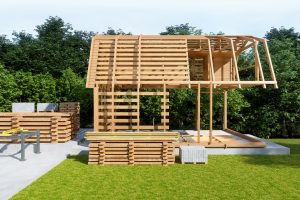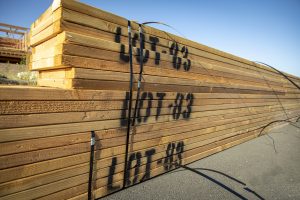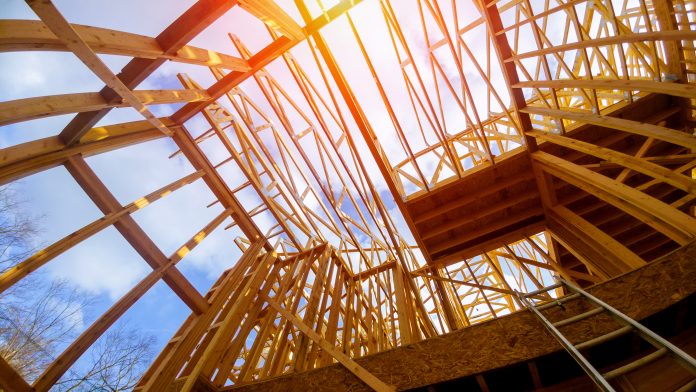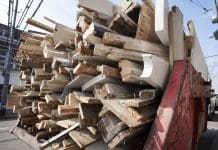Sustainable structural timber offers a range of benefits related to reducing the environmental footprint of buildings and construction processes. PBC Today explore how sustainable structural timber (SST) can contribute towards achieving net zero
The global climate crisis demands immediate action. To limit the effects of climate change, many countries have committed to achieving net zero carbon emissions by 2050. One potential solution for meeting this goal is sustainable structural timber (SST).
First, this article will examine how using SST in buildings reduces their embodied carbon – that is, the total amount of greenhouse gas released during the production process. It will then look at other advantages of SST, such as its durability and low maintenance requirements, which reduce energy use over time. Finally, it will identify opportunities for SST to achieve greater efficiency in construction projects and meet higher sustainability standards.
By exploring these various aspects, this paper seeks to demonstrate how utilizing sustainable structural timber could be an effective strategy for achieving net zero carbon emissions in the building sector by 2050.
Structural timber is a sustainable material used in the construction of buildings and can be produced from renewable sources
Structural timber is classified as an engineered wood product altered to increase strength, durability, flexibility and stability. Structural timber can be made into beams, joists, studs or purlins commonly used in flooring systems, wall frames and roof structures. Its low carbon footprint makes it a popular choice for builders looking to reduce their environmental impact while still achieving high-performance standards.
Structural timber offers other benefits, such as improved acoustic insulation because of its lightweight nature and natural insulating properties. Additionally, it is easy to work on-site due to no specialist tools being required. Furthermore, it does not require painting or additional treatments, making it a cost-effective alternative for many projects.
Structural timber provides an environmentally conscious solution when used correctly in building construction; this allows builders to reduce energy consumption associated with heating and cooling costs across multiple sectors, including residential housing and commercial offices.
What are the benefits of sustainable structural timber?
Sustainable structural timber has been widely accepted as a viable alternative to traditional building materials. Sustainable structural timber offers many benefits, including environmental sustainability, cost-effectiveness, and easy installation.
Environmental sustainability is one of the most important advantages of using sustainable structural timber in construction projects. As it is sourced from sustainably managed forests, the environmental impact is minimal. This means that the carbon emissions produced during production are reduced significantly compared to other building materials such as steel or concrete. In addition, once installed, this type of timber can help reduce energy consumption and improve air quality by acting as an effective insulation material and absorbing CO2 from the atmosphere.
Cost efficiency is another benefit offered by sustainable structural timber. It requires less energy to produce than non-timber alternatives, which helps keep costs down for manufacturers and builders alike. Furthermore, due to its lightweight nature, it does not require additional support structures, which further reduces overall project costs. Finally, because it can be easily cut into various shapes and sizes at low cost, it provides greater design flexibility which allows architects more freedom in their designs while also helping them stay within budget constraints.
Installation time is also much shorter when using sustainable structural timber than other building materials due to its lightweight and flexible nature. It allows complex projects to be completed quickly without compromising safety standards or quality control measures. This makes it possible for large-scale projects to be finished faster without adding extra resources or personnel, making it ideal for meeting tight deadlines set by clients.
What are the challenges associated with using sustainable structural timber?
Although sustainable structural timber offers many benefits, some challenges must be addressed. Many of these issues arise from the use of unfamiliar materials and methods in construction. In addition, strict regulations must be followed, which can add complexity and cost to a project.
One challenge is understanding the properties and performance of different timber species when exposed to various weather conditions or other environmental factors. Due to its relative newness, long-term data on how these timbers behave over time is still limited compared to traditional building materials such as steel or concrete. Additionally, while much progress has been made in increasing the fire resistance capabilities of wood products, they typically require additional treatments or protective measures for applications where added protection is necessary.
The majority of sustainable structural timber systems rely upon advanced engineering and design techniques which may not always be available in certain locations due to a lack of expertise or resources. This means longer lead times for projects involving this type of product and higher costs associated with hiring specialised personnel who can provide the required services, including installation and maintenance. Furthermore, despite improvements in efficiency and material used during manufacturing processes, substantial amounts of energy are still needed to produce these components leading to increased emissions which could affect meeting net-zero targets.
Ultimately, careful consideration should be given when deciding whether or not sustainable structural timber will help achieve net zero goals depending on each specific situation taking into account all potential challenges along with the numerous advantages it provides.

Environmental impact of using structural timber
Structural timber is a sustainable building material with many advantages for the environment. It has a low embodied energy which means that it requires fewer resources to produce, transport and construct compared to other materials such as concrete or steel. Additionally, its production uses minimal fossil fuels, so fewer CO2 emissions are created.
Structural timber also helps sequester carbon dioxide from the atmosphere by absorbing it into wood cells during growth and storing it within the built structure over time. This makes timber an effective way of reducing both atmospheric levels of greenhouse gases and global warming potentials. Furthermore, because trees absorb water when growing, they can also help reduce surface runoff, soil erosion, flooding and drought events.
Structural timber additionally offers multiple benefits in terms of:
- Decreasing air pollution due to reduced transportation costs;
- Minimising waste stream outputs through recycling;
- Reducing noise pollution;
- Providing aesthetic appeal to buildings.
The use of structural timber, therefore, presents significant opportunities for achieving net zero status while providing environmental benefits throughout its entire life cycle.
Potential for renewable energy generation
As demonstrated, structural timber is a sustainable material choice with minimal environmental impacts. It follows then that it can also help achieve net zero emissions goals. One way this could be achieved is through the generation of renewable energy.
The use of wood as an energy source has been practised since ancient times and today continues in both residential and commercial settings. Wood-based biomass fuels account for nearly 10% of all primary energy consumption in the United States (U.S.). The U.S., along with other countries such as Sweden, Norway and Finland, are leading the way in terms of utilising wooden building materials for their potential to generate clean electricity from biomass sources such as wood chips or pellets.
Wooden buildings can even serve as mini power plants when combined with modern technology, such as solar photovoltaic cells on roofs or walls; heat pumps; air conditioning systems; or waste management systems. By installing these technologies within a building made of structural timber, it becomes possible to capture excess thermal energy produced by the structure, which can be converted into electrical energy for use elsewhere within the same building or sold back to the local grid network. This helps reduce reliance on fossil fuel-based energy supplies while simultaneously providing an additional revenue stream for property owners who choose to invest in new renewable energies generated by their structures’ resources.
This demonstrates how using structural timber presents not only environmental benefits but economic ones too – making it a viable option for helping reach global net zero emission targets while at the same time creating jobs and increasing economic growth opportunities throughout communities worldwide.
What are the economical benefits of using structural timber?
The economic benefits of using structural timber in construction are numerous. Structural timber is a cost-effective material, with less investment than traditional materials such as steel and concrete. It requires less energy to produce, which results in lower carbon emissions for production and transport. Additionally, due to its lightweight nature, it allows for shorter construction times and reduced labour costs. This can lead to significant savings on the initial purchase price and long-term maintenance costs.
Structural timber also offers increased potential for profit margins compared to other building materials. Its versatility provides more options when designing structures, allowing architects and engineers to create novel solutions that may not have been possible with other materials. Furthermore, there is a growing demand for green buildings that utilise sustainable materials such as wood; this presents opportunities for developers who choose to use structural timber.
Overall, structural timber provides many economic benefits which should be considered during the design process of any building project aiming at net zero targets. As well as offering environmental sustainability through reducing greenhouse gas emissions, it can provide financial savings throughout the life cycle of a structure – from procurement right through to disposal or demolition.
Construction techniques and design considerations play a key role in achieving net zero through the use of sustainable structural timber

Building with timber can reduce embodied energy, increase thermal performance, and provide a more aesthetically pleasing building envelope than conventional construction materials.
The table below illustrates some of the advantages of using sustainable structural timber for constructing buildings that will help achieve net zero:
| Advantage | Description | Example |
| Reduced Embodied Energy | Timber has lower levels of inherent energy compared to other construction materials like steel or concrete. This reduces emissions during production since fewer resources are needed to produce it. | The carbon footprint associated with producing wood is significantly less than the amount required for steel or concrete structures |
| Increased Thermal Performance | Structural timber components have higher insulation capabilities due to their cellular structure, which helps contain heat better within the building’s envelope. This reduces heating bills while also reducing CO2 emissions from HVAC systems. | Replacing traditional wall cladding with insulated timber panels can improve overall thermal performance by up to 30%. |
| Aesthetic Appeal | Sustainable structural timber offers an attractive visual appeal when used as part of a building’s exterior façade or interior finishes. It provides warmth and texture that can be difficult to replicate with conventional materials like bricks or blocks. | Using natural wood textures on walls and ceilings creates inviting spaces where people feel comfortable spending time. |
Overall, using sustainable structural timber for constructing buildings presents many benefits over conventional methods, such as increased thermal efficiency, decreased embodied energy, and aesthetic appeal – all helping reach net zero targets. Careful consideration must be considered when designing these structures; however, if done correctly, they offer an effective solution for creating low-energy, high-performance buildings that contribute positively towards achieving net zero goals.
Fire safety requirements for structural timber buildings
Moving on from construction techniques and design considerations, fire safety requirements for structural timber buildings can be met by considering several factors. The use of sustainable structural timbers is an important part of the process of achieving net zero. By utilising this type of material, a building’s structure will remain stable and secure even when faced with extreme temperatures caused by fire hazards.
There are four main points to consider when using sustainable structural timber:
- Fire retardant treatments must be applied and regularly maintained to prevent ignition and the spread of potential fires.
- Proper spacing between different materials should be considered to reduce the risk of combustion or heat transfer from one surface to another.
- Installation methods must also consider how ventilation affects the rate at which a fire may spread throughout a structure if ignited.
- Designs should include specific escape routes so occupants can access safe exits during emergencies.
By adhering to these guidelines, it is possible for structures built with sustainable structural timber to meet necessary fire safety standards while still being able to achieve net zero emissions goals over time. Through careful planning, engineering, and implementation strategies, architects can ensure that their projects provide protective measures and create aesthetically pleasing designs without compromising safety regulations.

Building regulations and standards for structural timber
Building regulations and standards for structural timber construction is essential in ensuring the successful implementation of sustainable timber as an effective solution towards achieving net zero. To ensure that these structures meet safety requirements, the building owner must comply with local codes and ordinances stipulating minimum design criteria and other performance requirements related to sustainability, such as energy efficiency and air quality control. Regulations also require a project engineer or architect to calculate load-bearing capacity based on wind speed, seismic activity, snow accumulation, and soil type.
Standards for building components used in timber construction have been developed by organizations such as American Wood Council (AWC). These standards specify technical details regarding lumber grade, moisture content levels, span tables, fastening schedules and connections detailing. AWC provides educational tools and training programs to teach professionals about proper installation techniques while incorporating best practices into their designs.
Sustainable structural timber is becoming increasingly popular due to its environmental friendliness; however, designers must understand all applicable regulations and standards before designing any timber structure. This will help them make informed decisions on efficiently achieving net zero by using reliable materials that adhere to the highest industry standards.
Life cycle assessment of structural timber buildings
The use of structural timber in building construction is becoming increasingly popular due to its sustainability credentials. To fully understand the impact of using such a material, it is necessary to conduct a life cycle assessment (LCA) for each proposed project. An LCA looks at all stages of the product or process from cradle-to-grave and assesses any potential environmental impacts that could occur throughout these stages. This includes looking at production, transportation, installation and disposal.
When considering an LCA for timber buildings, one must consider both upstream impacts (at the manufacturing stage) and downstream impacts (after construction). Upstream impacts can include energy consumption during production, emissions resulting from fuel used in transport vehicles as well as chemical by-products produced during treatment processes. On the other hand, downstream impacts may include ongoing maintenance requirements and eventual deconstruction/disposal considerations.
Overall, an LCA helps identify areas where improvements can be made to reduce negative environmental effects associated with timber structures. It also provides valuable insight into how sustainable structural timber can help achieve net zero targets by identifying opportunities to reduce carbon footprints through efficient design choices and best practice implementation strategies.
Innovative technologies to enhance the performance of structural timber
Sustainable structural timber is a popular building material for achieving net zero. Innovative technologies can be used to enhance the performance of timber and increase its sustainability.
| Technology | Benefits | Drawbacks |
| Cross Laminated Timber (CLT) | Reduced energy consumption, rapid construction time, durable | Cost-intensive, high moisture content sensitivity |
| Mass Plywood Panels (MPP) | Low embodied carbon emissions, cost-effective | Vulnerable to fire damage |
| Glued-laminated Timber (Glulam) | High strength properties, the fast installation process | Poor thermal insulation characteristics |
CLT is an engineered wood product that uses several layers of thin lumber boards glued together with their grains perpendicular to each other. This increases its strength and stability while reducing energy consumption during production. The reduced construction times associated with CLT make it more efficient than traditional wood framing methods. However, this technology is cost intensive compared to other materials and has higher moisture content sensitivity which may cause issues in certain climates.
MPP utilises large panels of thin veneer layers bonded together using adhesives or hot press bonding techniques. It reduces embodied carbon compared to concrete or steel structures due to its lower density and lighter-weight components. Additionally, it is one of the most cost-effective options available on the market today, making it attractive both economically and ecologically speaking. Despite these advantages, MPPs are vulnerable to fire damage if not protected properly by external coatings or cladding systems.
Finally, glulam involves laminating individual pieces of lumber into larger beams by applying strong adhesive resins between them as well as mechanical connections such as nails or bolts. These beams have superior bending capabilities, which make them ideal for curved roofs or columns and can be installed faster than conventional timber structures due to their lightweight nature. On the downside, though, they lack proper insulation characteristics, thus needing additional protection from external elements such as roofing membranes or facade systems to achieve optimal results.
Cost comparison of sustainable structural timber with conventional materials

The cost-effectiveness of sustainable structural timber compared to conventional materials is an important factor when considering its use for achieving net zero. As such, it is necessary to analyse the potential savings from using timber versus other materials. The costs associated with harvesting and processing timber can be significant; however, certain circumstances may make the financial investment worthwhile. For example, if a project requires more extensive labour than material costs, sustainable structural timber could offer a greater return on investment due to its lightweight and ease of installation.
In addition to upfront expenses, there are long-term economic benefits that come with using sustainable structural timber over traditional building materials. Timber’s durability means that maintenance requirements are drastically reduced compared to those associated with conventional construction methods. This helps maintain lower life cycle costs since any repairs needed will likely not be as costly or frequent as they would be otherwise. Additionally, because wood is naturally energy efficient due to its low thermal conductivity and capacity for insulation, energy bills can also decrease significantly.
Overall, sustainable structural timber can provide lasting value while helping achieve net zero goals at both initial cost and long-term savings. Its versatility makes it suitable for many different types of applications where lightweight performance and sustainability are desired qualities. With all these factors considered, sustainable structural timber offers an attractive option for projects that seek efficiency without sacrificing quality or functionality.
International examples of net zero buildings using structural timber
Structural timber has been used in the construction of net zero buildings around the world. For example, a school in Glarus, Switzerland, was built with structural timber and achieved its goal as a carbon-neutral building through renewable energy sources such as solar panels and battery storage systems. The innovative design included an exposed timber structure which created an aesthetic that combined modern technology with traditional woodworking techniques.
In Stockholm, Sweden, another net zero building made from structural timber is home to offices for the Swedish Environmental Protection Agency (SEPA). This project aimed to create an office space that could produce more energy than it consumes using passive strategies and active technologies such as geothermal heating pumps. A large portion of the building’s façade is comprised of cross-laminated timber (CLT) panels, while other parts feature glulam beams and columns, providing both thermal insulation and soundproofing qualities.
Structural timber in these examples demonstrates how this material can be employed to build sustainable structures that achieve net zero status. Not only does it provide strength and stability, but it also offers environmental benefits due to its natural properties, like the ability to store carbon emissions long term. Additionally, CLT panel walls are fire resistant, making them suitable for public spaces where safety is paramount. As such, incorporating structural timber into net zero projects provides many advantages over conventional materials leading to increased efficiency and improved performance overall.
Government policies to support the use of sustainable structural timber
Using sustainable structural timber in constructing net-zero buildings is becoming increasingly popular for its numerous advantages. To further support this trend, governments worldwide have implemented various policies to encourage and incentivize the adoption of such materials.
One example of government policy is regulations that mandate or give preference to green building methods, including using renewable resources like wood. For instance, Singapore’s Building and Construction Authority (BCA) has enacted rules requiring all new public buildings to be constructed with at least 30% certified wood from sustainably managed forests. In addition, countries like Finland are providing incentives for developers who commit to using certified wooden products by offering discounts on taxes related to development projects.
Other initiatives include subsidies to reduce costs associated with purchasing materials from more expensive renewable sources. The EU’s Timber Regulation provides an example as it restricts certain unsustainable timber imports while providing grants towards reducing prices paid for legal forestry products sourced within Europe. These financial incentives can make utilizing sustainable structural timber a much more attractive option than other non-renewable alternatives, thus increasing their usage across multiple industries worldwide.
Timber can be an effective and efficient building material for low-carbon construction, with the potential to significantly contribute to reaching global emission reduction targets. Its advantages include high thermal performance resulting from its natural insulation properties, as well as fast installation times due to its ease of fabrication. Additionally, wood sequesters carbon dioxide from the atmosphere during growth and provides attractive aesthetic qualities that are increasingly being recognised by consumers.
It is important to consider the limitations associated with using timber for low-carbon structures too. The availability of suitable resources needs careful consideration; certified sources should always be sought where possible. Other environmental impacts such as water usage, energy consumption during production, transport distances and waste management must also be considered when designing with timber to ensure sustainability credentials are met.
Overall, it appears that the benefits offered by sustainable structural timber outweigh any potential drawbacks when used appropriately within modern construction projects aiming for net zero goals. With technological advancements and increased awareness around sustainability issues related to buildings continuing to grow, there is no doubt that this product will have further positive effects on climate change mitigation strategies moving forward.
Frequently asked questions
What is the cost difference between sustainable structural timber and conventional materials?
Sustainable structural timber is an increasingly popular construction material, with its cost difference from conventional materials being a key factor in its implementation. When considering the cost of sustainable structural timber vs conventional materials for achieving net zero, several elements must first be considered.
- The initial purchase costs
- Labour and installation expenses
- Long-term maintenance requirements
The initial purchase costs of sustainable structural timber are usually higher than those of traditional building materials such as steel or concrete due to their limited availability. However, this premium can often be offset by savings incurred through labour and installation expenses because wood is lighter and easier to work with than other materials. It also requires fewer tools and specialised skillsets during installation when compared to steel or concrete structures that require welding expertise or heavy machinery operations, respectively. Additionally, long-term maintenance costs associated with wood are generally lower since it is more resilient against corrosion, water damage, fire risk, etc., compared to standard construction materials like steel and concrete.
Overall, while the upfront investment may appear daunting at first glance when considering factors such as labour costs and long-term maintenance requirements, there can often be significant cost advantages associated with utilising sustainable structural timber instead of traditional building materials. As environmental legislation tightens around energy efficiency measures for new constructions and renovations, these cost benefits will continue increasing.
Are there any government policies to support the use of sustainable structural timber?
In recent years, sustainable structural timber has become increasingly popular due to its environmental benefits. As an alternative to conventional building materials such as steel and concrete, this type of timber is seen by many governments as a way of achieving net zero emissions. One question that arises in this context is whether there are any government policies designed to support the use of sustainable structural timber.
To answer this query, it is necessary to understand how different countries approach timber construction from a regulatory perspective. Many national governments have adopted legislation that incentivises using sustainably sourced wood products in buildings and other structures. For example, some European countries have established comprehensive certification systems encouraging developers and builders to utilize certified lumber from well-managed forests. These initiatives help ensure that the timber used meets sustainability standards set out by local authorities or industry bodies. Additionally, various European states offer financial support for projects utilizing sustainable building materials, including structural timber.
It should also be noted that many governments worldwide are attempting to reduce their carbon footprint through increased energy efficiency targets and renewable energy sources like solar panels and wind turbines. To achieve these goals, they often provide public subsidies for businesses that invest in green solutions, such as those involving sustainable structural timber. This contributes towards creating a more environmentally conscious society with reduced greenhouse gas emissions overall.
Overall, it is clear that many national governments are taking steps to promote the use of sustainable structural timber in construction projects across the globe. From providing incentives for certifying lumber from managed forests to offering financial assistance for companies investing in green solutions, there are numerous policy options available which aim to create a greener future while simultaneously helping nations reach their climate change objectives.
What fire safety requirements must be met for structural timber buildings?
When constructing a building, one of the foremost considerations is fire safety- and this is especially true for buildings constructed with structural timber. Structural timber has been used as an effective building material for centuries, but it does have certain limitations regarding its performance in high-temperature situations. To ensure that a structure made from timber meets all necessary fire safety standards, there are several requirements which must be met.
Firstly, the type of wood chosen should be carefully selected based on its suitability for use in various environments. Hardwoods such as oak or ash are more suitable than softer woods like pine due to their greater resistance to heat and flame. Secondly, any combustible materials used with the wood should also be treated appropriately; insulation and other similar materials may need special protection against fire hazards. Finally, regular maintenance should be carried out to check that no areas of exposed wood remain unprotected by coatings or treatments.
Implementing these fire safety requirements can help guarantee the safe construction of buildings made from structural timber. Of course, this process needs to take place alongside maintaining stringent quality control throughout the entire project lifecycle – from design through to completion – if a successful outcome is desired. As such, when considering sustainable structural timber for construction projects, adequate provisions must be made to meet required fire safety regulations.
What are the innovative technologies used to enhance the performance of structural timber?
Structural timber is an increasingly popular material for construction due to its sustainability, affordability and versatility. However, various fire safety requirements must be considered when constructing with structural timber to ensure the safety of occupants and those working on the project. In addition to this, innovative technologies have been developed which aim to enhance the performance of structural timber buildings.
One such technology is flame retardant treatments (FRTs). FRTs can reduce a product’s flammability rating by providing a protective layer between wood fibres and flames. This allows more time for evacuation or intervention from firefighters during any potential emergency situation. Another example is spray-on intumescent coatings which expand when subjected to heat, thereby protecting underlying materials from burning. Finally, sprinklers provide an automated response system against fires, thus reducing their spread throughout structures of structural timber.
It is clear then that new technological developments have had a significant impact on structural timber’s ability to meet fire safety regulations while also allowing builders greater flexibility in design implementation. These measures are essential for guaranteeing the safe use of structural timber as it becomes more widespread within modern architecture. Moreover, these advances demonstrate the commitment of manufacturers to continuously improve the quality of their products and advance the cause of sustainable building practices worldwide.
Is there potential for renewable energy generation with sustainable structural timber?
Sustainable structural timber is a form of engineered wood made from trees that are sourced responsibly and managed in such a way as to minimise their impact on the environment. This type of material has become increasingly popular due to its versatility and strength, making it suitable for many construction projects.
Regarding renewable energy production, studies have shown that sustainable structural timber can be combined with other technologies to create efficient systems capable of producing electrical power. By utilising solar panels or wind turbines along with thermal collectors, these structures could provide an additional source of clean energy. Additionally, some research suggests that biomass-based systems may be viable options for generating electricity with sustainable structural timber materials.
Overall, while further study is needed before any definitive conclusions can be drawn about the use of this material for energy production purposes, initial evidence suggests that there is significant potential for harnessing renewable energy through the use of sustainable structural timber. The ability to produce electricity from these materials would undoubtedly benefit people and the planet by reducing reliance on non-renewable sources while contributing towards net zero emissions goals.
Sustainable structural timber has the potential to play an important role in achieving net zero
The cost of sustainable timber can be competitive with conventional materials, and government policies are in place to encourage its use. Fire safety requirements for buildings constructed from structural timber have been established, and innovative technologies exist to enhance the performance of this material. Furthermore, renewable energy generation may be achievable when using sustainable structural timber as a building material.
In conclusion, sustainable structural timber could provide significant benefits towards achieving net-zero emissions targets. As such, further research into the performance characteristics of this material should be conducted so that more informed decisions can be made about its use in construction projects. Additionally, public policy initiatives must continue to promote the adoption of sustainable timber products if they are going to make a substantial contribution towards reducing global carbon emissions levels.














